The 5 Best Pumps for Homebrewing [2022]
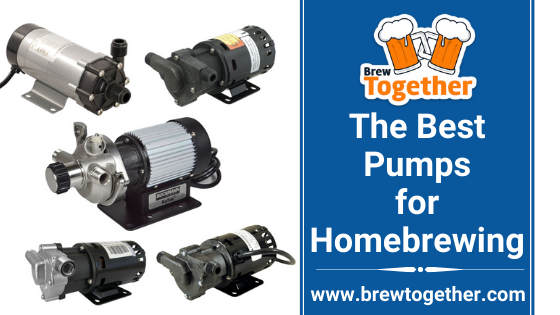

There are a lot of equipment investments that homebrewers make over the years, but there aren’t many that improve the experience of brewing as much as adding a pump. It can take a little bit of getting used to, but once you have it down it’s pretty amazing not to be lifting, pouring, and siphoning gallons and gallons of water and wort. With the increasing shift towards electric brewing, especially using all-in-one electric brewing systems (here’s a list of our favorites), pumps are becoming increasingly common and important in homebreweries. There are a TON of pumps available that span a huge range in terms of price, quality, and features. It can be overwhelming, so we did the research for you! Here are our picks for the best pumps for homebrewing!
Considerations When Choosing a Brewing Pump
There are several considerations you should make when choosing a homebrewing pump:
Material
Pumps are usually made from plastic (often called polysulfone), stainless steel, or a combination of both. Plastic components reduce the price of the pump, but can become brittle over time and the threading on the pump head is prone to damage.
High Temperature Tolerance
An effective brewing pump needs to be rated for high temperatures so that it can be used for a recirculating mash or even for moving boiling wort to another vessel or through a wort chiller. Most plastic or self-priming pumps aren’t rated for boiling temperatures, though some are able to handle mash temperatures.
Self-Priming
Self-priming pumps are airtight and create suction that pulls the liquid out of the vessel, so they don’t need to be set below the vessel to use the force of gravity to move the liquid. Unfortunately, magnetic drive pumps are not self-priming because they do not suck air sufficiently to pull wort from the vessel. Because of this, self-priming pumps work better for the cold side but are not generally able to be used with hot or boiling wort.
Magnetic Drive
In a magnetic drive pump, a magnet is attached to the end of the drive shaft and another magnet is attached to the impeller so that the magnetic attraction causes the impeller to spin as the drive shaft does. Using a magnetic drive pump is important because it allows you to restrict the flow of the out-line on the pump with either a ball valve or a compression fitting. This is especially important for recirculating mashes where reducing the flow of wort is imperative to reducing stuck mashes. Unfortunately, magnetic drive pumps do not create air suction, so they are not self-priming. This makes them the best choice for pumping liquid on the hot side.
Connections
Another consideration when choosing a pump is the connections on the pump head. Most pumps come standard with ½” threaded fittings that can be used with standard brewing hoses, but options for heads with barbs or higher-end connections like tri-clamps are available.
Maximum Lift
Maximum lift refers to the maximum height difference between the origin of the liquid and the destination. Consider your brewing setup when determining the amount of lift needed to move the water or wort between vessels to make sure it will have enough power.
Maximum Flow Rate
Finally, comparing the maximum flow rates of each pump is worth considering, especially if you are brewing larger batches or have a need for a faster, more powerful pump. Most homebrewing pumps have maximum flow rates of about 7-8 gallons per minute (GPM).
Brewing Pumps Comparison Chart
Affiliate Disclosure: BrewTogether is a participant in various affiliate programs, including the Amazon Services LLC Associates Program, an affiliate advertising program designed to provide a means for us to earn fees by linking to Amazon.com and affiliated sites. Some of the links in this article are affiliate links, which means that if you choose to make a purchase after clicking the link, I will earn a small commission at no additional cost to you, which helps offset the cost of running BrewTogether. Please feel free to reach out with questions. Thank you so much for your support!
| Pump | RipTide Brewing Pump by Blichmann Engineering | Chugger Pumps X-Dry Series | March Pump - Polysulphone | Chugger Pump - Polysulphone | MKII High Temp Magnetic Drive Pump |
| Image | 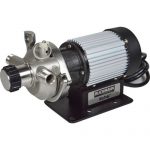  | 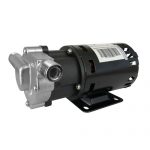  |   |   |   |
| Price | $199.99 | $179.99 | $179.99 | $129.99 | $74.99 |
| Maximum Flow Rate | 7 GPM | 7 GPM | 7 GPM | 7 GPM | 5 GPM |
| Maximum Lift | 21 feet | 18.6 feet | 18 feet | 18.9 feet | 11 feet |
| Material | Stainless Steel | Stainless Steel | Polysulphone | Polysulphone | Polysulphone. Optional stainless steel head available for $29.99 |
| Heat Tolerance | Heat resistant to boiling temperatures | Heat resistant to 250° F | Heat resistant to boiling temperatures | Heat resistant to 250° F | Heat resistant to mash and post-boiling temperatures |
| Drive Type | Magnetic Drive | Magnetic Drive | Magnetic Drive | Magnetic Drive | Magnetic Drive |
| Self-Priming? | Not self-priming, but includes air-release valve that makes priming easy | Not self-priming, but has dry-run protection from a carbon bearing included | Not self-priming | Not self-priming | Not self-priming |
| Connection Type | 1/2" NPT inlet and outlet connections come standard, Tri-clamp version and upgrade kit are available | 1/2" NPT inlet and outlet connections | 1/2" NPT inlet and outlet connections | 1/2" NPT inlet and outlet connections | 1/2" NPT inlet and outlet connections |
The Best Pumps for Homebrewing
Best Overall: RipTide Brewing Pump by Blichmann Engineering – $199.99
The single most recommended pump for homebrewing is the RipTide Brewing Pump by Blichmann Engineering. It has the most built-in features of any pump on this list, making the $199.99 price point less expensive than it initially seems.
The RipTide features a built-in flow control valve, eliminating the need for an in-line ball valve or compression flow restrictor. It also includes a built-in pull-valve that releases air from the head, which allows you to prime the pump easily and reduces cavitation (the production of bubbles in the pump).
Its metal construction and stainless steel head are built to last, and the impeller is spun using rare earth magnets that form a strong magnetic connection. The RipTide comes standard with ½” NPT inlet and outlet connections that connect to standard brewing lines, but there is a tri-clamp version and a standalone tri-clamp upgrade kit available as well. With a max flow rate of 7 GPM and a max lift of 21 feet, the RipTide can handle large batches and moves wort efficiently on larger systems.
Overall, the RipTide is an incredibly well-built pump that you definitely won’t regret investing in if it fits your budget.
Chugger Pumps X-Dry Series – 179.99
If you don’t choose a Blichmann RipTide, our next-favorite pump for homebrewing is the Chugger Pumps X-Dry Series. This is an awesome stainless steel pump handles boiling temperatures with ease, and has a maximum operating temperature of 250° F. It has a magnetic drive and is not self-priming but it has a dry run protection from a carbon bearing that reduces the concern with accidentally running it dry and burning out the motor. It does not come with a built-in flow control valve, but a ball valve can be easily installed on the outflow.
With a max flow of 7 GPM and a max lift of 18.6 feet, the Chugger Pumps X-Dry Series is an awesome pump that advanced brewers will love having in their system.
March Pump – Polysulphone – $179.99
March pumps are the original homebrewing pumps and have been the standard for a long time. They are exceptionally well-built pumps for homebrewing, but don’t come with some of the features of the Blichmann RipTide or Chugger X-Dry Series pumps. This March Pump is constructed of polysulphone plastic, but it is still able to withstand hot and even boiling temperatures. It has a magnetic drive but does not come with a flow control, but one can be added on the outflow easily. This March Pump is not self-priming, and has had some minor issues with cavitation, but it’s still an excellent pump from a great pump.
With a max flow of 7 GPM and a max lift of 18 feet, this pump is up to the challenge of larger batches on larger systems. March pumps are built to last!
Chugger Pump – Polysulphone – $129.99
Chugger Pumps are built to be similar to March Pumps, with similar features and specifications at a lower price. The Polysulphone Chugger Pump is very similar to the March Pump version. In fact, the biggest difference between the two is the price, with the Chugger version coming in $50 less than the March Pump. It is constructed from polysulphone plastic that is food-grade at up to 250° F, making it a great hotside pump that has no problems with mash or boil temperatures. It has a magnetic drive, does not include a flow-control valve (but one can be installed on the outflow easily), and is not self-priming, but at only $129.99 a few accessories make the Polysulphone Chugger Pump a great pump at a great price.
With a max low of 7 GPM and a max lift of almost 19 feet, this pump is appropriate for almost any system.
Best Budget Pump: MKII High Temp Magnetic Drive Pump – $74.99
If you’re on a tighter budget and are looking for a pump under $100, we recommend the MKII High Temp Magnetic Drive Pump. At only $74.99 on MoreBeer, this is a great pump at a much lower price. It is made from polysulfone rather than stainless steel, but it is high-temperature ready and can withstand mash and even immediately post-boil temperatures. If you prefer to avoid plastic, there is an optional stainless steel pump head for the MKII Pump available on MoreBeer for only $29.99. The MKII has a magnetic drive and is not self priming, and though it does not have a built-in flow control, it is easy to add a ball valve on the outflow side.
It has standard ½” NPT inlet and outlet connections but does not come with any hoses. The MKII has a max flow of 5 GPM and a max lift of 11 feet, so it may not be powerful enough for brewing larger batches or on some systems, but for the average homebrewer this is a great brewing pump at a great price.
Thanks for Reading!
Did we miss your favorite pump for homebrewing? Have questions or feedback about one of these pumps? Leave a comment below or post in the BrewTogether forums!
Thank you for reading! If you like this article, it would mean the world to us if you would share it with your friends using the social media share buttons below.
If you’re not a member of BrewTogether, we’d love for you to join! BrewTogether is completely free, and signing up is easy! Click here to join!



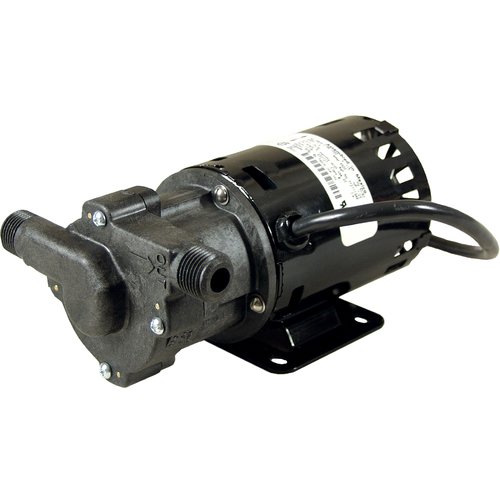
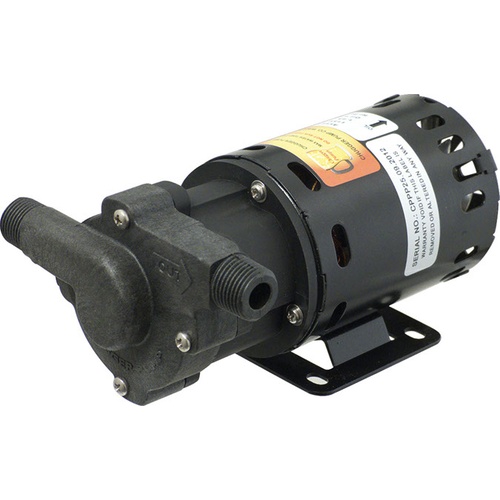
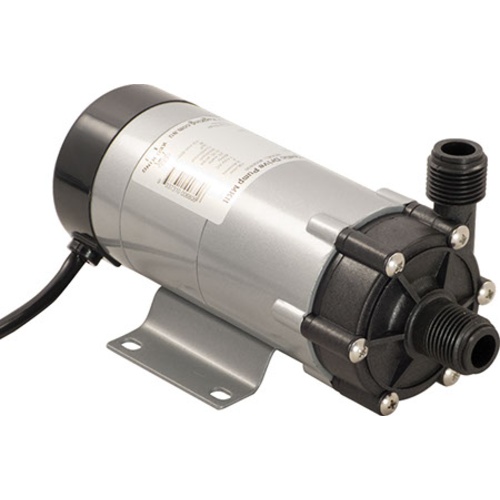


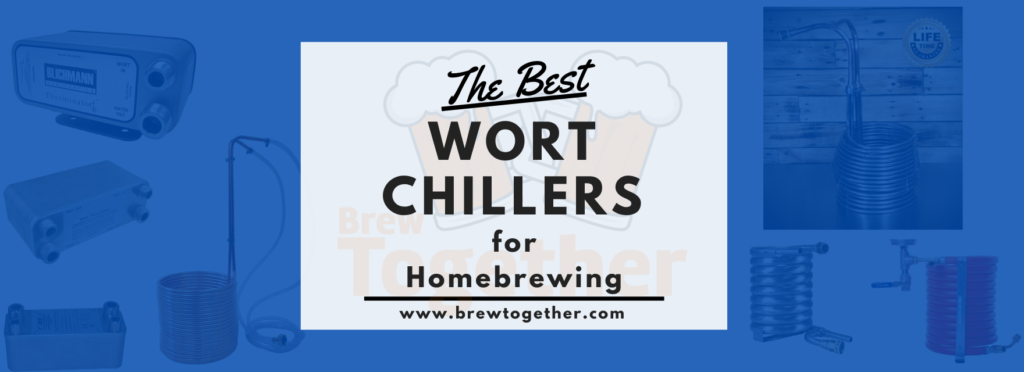
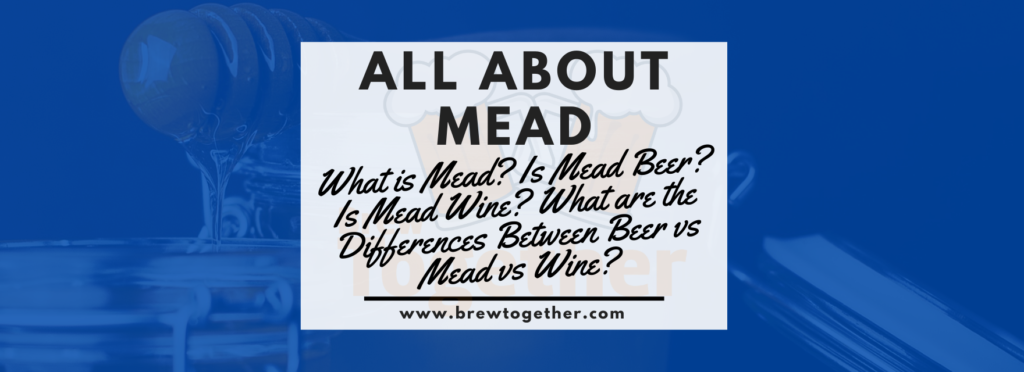

Responses